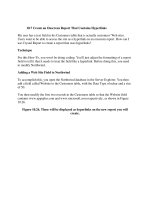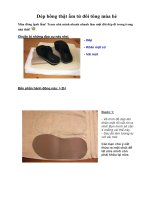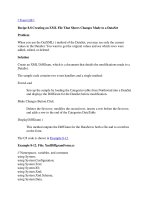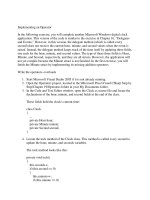Create an Ear Drawing That You Will Want to Hear About! doc
Bạn đang xem bản rút gọn của tài liệu. Xem và tải ngay bản đầy đủ của tài liệu tại đây (34.42 KB, 6 trang )
Create an Ear Drawing That You
Will Want to Hear About!
An ear drawing is no different than a drawing of any other part of the face. If no
other part of a head drawing, you will want to keep this one the simplest as well as
in the correct placement on the head.
If you really look at the ears, they are really crazy looking things. They come in all
shapes and sizes and can have varying degrees of hair on or in them. They also
have an unlimited amount of items and objects that can be pierced through them.
In my opinion, ears are actually kind of one the most unattractive parts of the body
or at least have the potential to be. When creating an ear drawing, it is important to
keep them as simple as possible or they will look overworked and they will draw
attention to themselves for the wrong reasons.
KEEP IT LIGHT AND SIMPLE
There is quite a lot of detail in the ear. It is important when drawing to not get too
involved and distracted with trying to draw it all. When drawing the ear, you will
want to keep your lines soft and light.
Tip: Squinting your eyes removes the detail and lessens the color you see, only
allowing for the most dominate tone and form to be viewed. This little trick can
also help when you want to learn to do a drawing of anything that has a lot of
detail. It is one of the oldest tricks in the book and can be very useful when
breaking down tone and form. It is also simple and free.
NO HARD EDGES
There are no hard edges on the face. Unless you are doing illustrations with ink
and hard contour lines, you will not want to have any hard edges except maybe on
the outer contour of the ear. When drawing the lines in the center of the ear, you
will want to keep them light and simple. Hard lines and too much shading will
lead to a "heavy" overworked-looking ear, and it will look like it doesn't belong to
its head.
I cannot stress enough how simplicity and delicate lines are your friends when it
comes to ear drawing. Since there are so many lines and forms involved in the ear,
it is easy to get caught up with drawing every crevice and over-shade it. It can be a
little tough to find this balance of hard and softness. Only practice will help with
finding it.
The Different Looks of the Ear
When drawing the face or head, it will most likely not just be a straight on or a
profile view. These obviously do occur, but the head will more often be drawn on
an angle. The best way of drawing and learning these different angles is to actually
observe and practice drawing them. Since looking in the mirror to get all of these
angles is almost impossible and staring at and studying strangers' ears can tend to
make them a little uncomfortable, I have made this reference sheet for you to use.
The Main Parts of the Ear:
There are roughly 3 landmarks of the outer ear that will make it distinguishable.
The Rim:
There is a slight rim on the outer part of the ear that is used to help catch sound
and direct it to the inner part of the ear. If drawn with too hard of a line it can
make it look like an unnatural plastic doll ear. The "Keep it Simple" rule applies
here just as with every other part of the ear drawing. Get ready to get sick of
hearing that if you aren't already.
The Lobe:
The Lobe is obviously a major part of the ear which if left off will really make
your ear look even more weird than it already does. I don't think you will have an
issue with forgetting this part; however it can be a little tricky to draw as some
ears have large lobes and some seem to almost connect directly to the head. This
still can be one of the easiest parts of the ear drawing.
The Crest:
This part of the ear is where you can go terribly astray if not kept simple. Since
there is a gradual curve to this part of the ear it is very easy to keep shading and
shading and shading this part. This is where your ear can turn into a flat
overworked alien ear or an ear with life and depth. KEEP IT SIMPLE!
Squint those eyes and draw the basic lines that you see.
The gradation will go away leaving you to draw the main line that creates this
section of the ear. If you must draw the shading ,draw only the darkest tones that
you see when squinting. This part of the ear also includes that little bridge that is
made up of cartilage that a lot of people get pierced. Again do not overwork this
area. You will see better results with less line and less shading. If no other section
of the ear, this "Crest" section can really make the ear look off if not drawn
simply.
Hopefully this has given you a good understanding of how to draw a solid ear
drawing. The reference of the different angles will also help you practice drawing
the different angles and views of the ear. Once you learn how to draw the main
parts of the ear simply and at any angle you will be on you way to mastering head
construction.









